As I enter my Zen-inspired living room, I feel a deep calm. The soft light from the sheer curtains warms the space. The scent of incense and the sound of a fountain add to the peaceful atmosphere. This room is my haven, where I can relax and find peace.
Creating a Zen room is more than a trend. It’s a lifestyle that values simplicity, mindfulness, and nature. In this article, we’ll look at the top 7 Zen room decor elements. They can turn your living space into a calm and serene oasis.
Key Takeaways
- Zen decor focuses on simplicity, natural materials, and minimalist design
- Incorporating Zen elements can create a calming and peaceful living environment
- Thoughtful selection of furniture, colors, and accessories is key to achieving a true Zen aesthetic
- Incorporating Feng Shui principles can enhance the energy flow and balance of a Zen-inspired space
- Lighting and decorative accents play a vital role in establishing a serene and tranquil ambiance
Understanding the Philosophy Behind Zen Room Design
Zen room decor comes from Japan’s rich culture. It’s based on Zen Buddhism, focusing on simplicity and love for nature. This design helps create a peaceful space that encourages mindfulness and balance.
Origins of Zen Interior Design
The roots of Zen design are in the Japanese tea ceremony, or “chanoyu.” This ceremony, centered on matcha tea, led to a design philosophy of harmony and simplicity. It has shaped Japanese architecture and home decor, becoming a symbol of japanese inspired interiors and minimalism.
Core Principles of Zen Aesthetics
- Minimalism: Zen design is all about simplicity, focusing on what’s essential and removing distractions.
- Natural Materials: Zen room decor uses wood, bamboo, and stone to connect with nature.
- Asymmetry and Imperfection: Zen celebrates the beauty of imperfection and asymmetry, showing life’s fleeting nature.
- Negative Space: Zen spaces have lots of empty space, promoting openness and calm.
Benefits of Zen-Inspired Spaces
Designing a space with Zen principles can greatly benefit your well-being. It brings calm and mindfulness, reducing stress and anxiety. It also strengthens your connection with nature, leading to a better sense of balance and well-being.
“Zen is not some kind of excitement, but concentration on our usual everyday routine.” – Shunryu Suzuki
Essential Elements of Mindful Living Spaces
Creating a mindful living space is key to feeling calm and balanced every day. By adding zen furniture and peaceful home decor, we can make our homes peaceful. Let’s look at the main parts that make a mindful living space special.
Simplicity is at the heart of a zen-inspired home. Clean lines, minimal design, and practical furniture help us feel clear and calm. A clutter-free space and carefully chosen items make it feel open and focused.
Harmony and balance are vital in a mindful living space. The right furniture placement, natural elements, and colors create a peaceful vibe. This balance helps our minds relax and connect with the now.
Using natural materials like wood, stone, and organic fabrics adds a calming touch. These elements make the space look good and feel connected to nature. This is important for peaceful home decor.
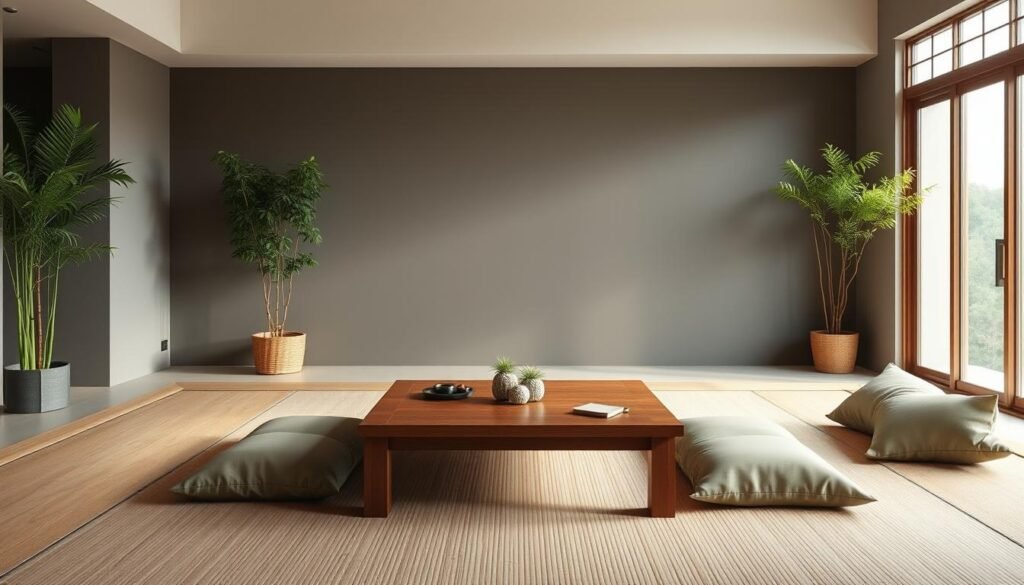
In the end, the key elements of a mindful living space come together to make a place of calm and reflection. By carefully choosing these elements, we can turn our homes into peaceful home decor havens. This way, we can live a more zen-inspired life.
Natural Materials and Textures in Zen Decor
In Zen room decor, natural materials and textures are key. They help make a space calm and harmonious. Using these elements, you can turn your home into a peaceful place that shows the Japanese-inspired style.
Bamboo and Wood Elements
Bamboo and wood are symbols of Zen interiors. They add warmth and texture, showing our bond with nature. Use bamboo for screens or furniture for elegance. Wood, with its grain and colors, brings a calming feel.
Stone and Natural Textile Applications
Adding stone and natural textiles deepens our connection to nature. Stones, like tabletops or garden features, bring tranquility. Natural fabrics, like linen or cotton, add texture and a soothing feel.
Organic Material Selection Guide
- Bamboo: Versatile, renewable, and visually striking, bamboo is a popular choice for Zen room decor, from furniture to accent pieces.
- Wood: Opt for unfinished or minimally treated wood surfaces, such as oak, maple, or cherry, to enhance the natural beauty.
- Stone: Incorporate smooth, natural stones like river rocks, slate, or granite to create a grounded, earthy atmosphere.
- Natural Textiles: Choose fabrics like linen, cotton, or jute to add texture and a soothing, organic touch to the space.
By choosing and using these natural materials, you can make a Zen-inspired space. It will look great and help you feel calm and mindful.
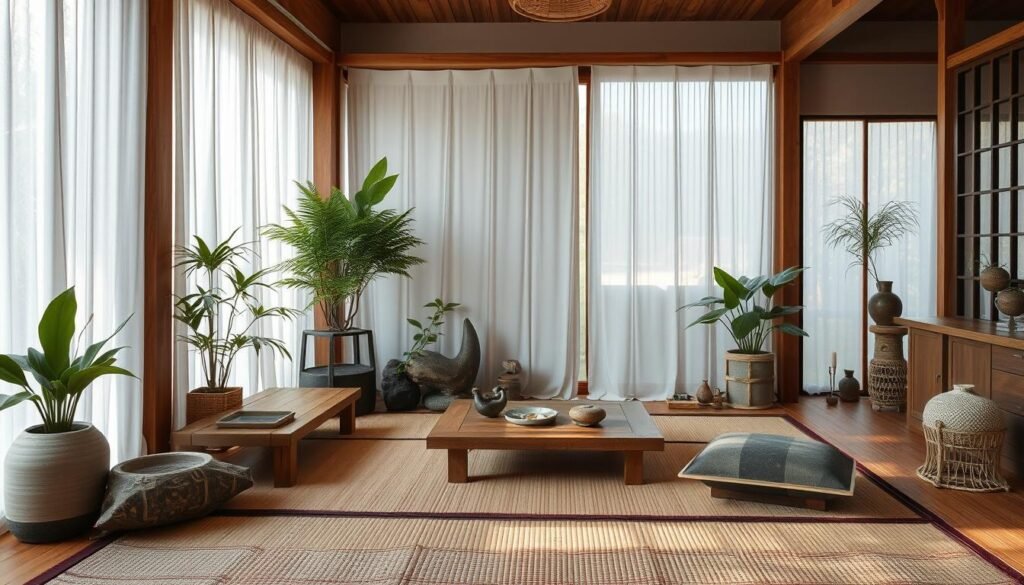
Top 7 Zen Room Decor Elements for Ultimate Tranquility
Creating a peaceful home is easy with the right Zen decor. From soothing water sounds to simple art, these ideas can make any room calm and serene.
- Water Features: The sound of flowing water is key in Zen design. Add a tabletop fountain or a wall-mounted feature for a meditative feel in your peaceful home decor.
- Bonsai Trees: These small trees stand for harmony and balance, great for any meditation room ideas. They add natural beauty to your space.
- Natural Lighting: Zen design loves natural light. Use sheer curtains or sliding screens to let sunlight in gently.
- Minimalist Art Pieces: Simple art, like calligraphy or abstracts, adds calm and focus. It’s a key part of Zen decor.
- Bamboo Accents: Bamboo’s clean lines and organic feel are perfect for Zen. Add bamboo items, like a table or screen, for a natural vibe.
- Incense and Candles: Incense and candles create a soothing atmosphere. They help make your peaceful home decor even more relaxing.
- Zen Garden Elements: Indoor Zen gardens bring calm with stones, sand, or small plants. They turn your space into a meditation room ideas.
With these Zen decor elements, you can make a peaceful and calming space. It’s a place for mindfulness and relaxation in your home.
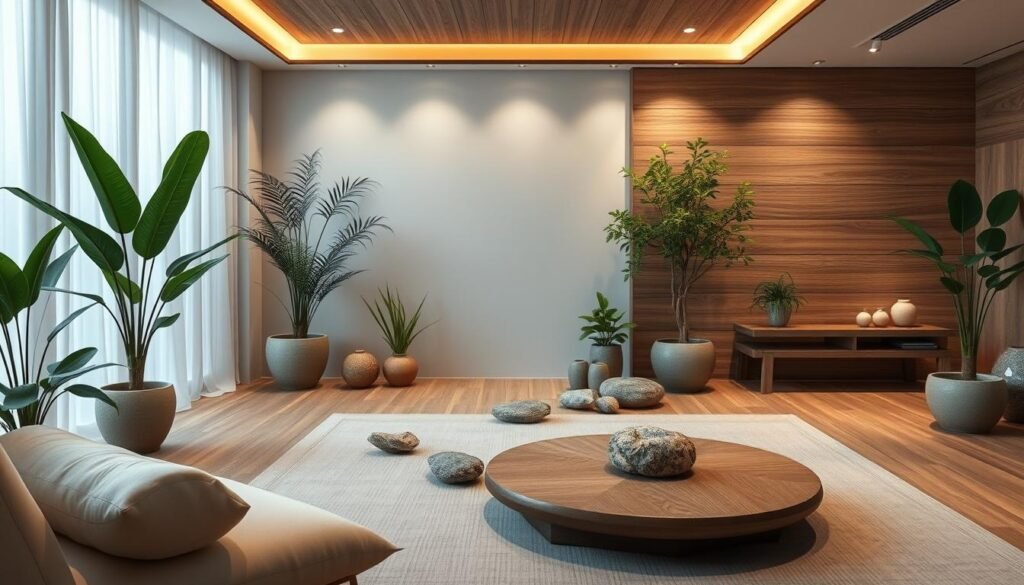
Creating Balance with Feng Shui Principles
To make your zen room peaceful and harmonious, it’s not just about the decor. Using Feng Shui principles can help improve the energy flow. This makes your living space balanced and peaceful. Let’s explore the main parts of Feng Shui-inspired zen room design.
Room Layout Optimization
The way you arrange furniture in your zen room affects the energy flow. Follow Feng Shui to get a balanced layout. Don’t put furniture in front of doors or windows, as it blocks energy flow. Place furniture to allow for a smooth path through the room.
Energy Flow Enhancement
Improving the energy flow, or “chi,” is key in Feng Shui. Add elements like mirrors, water, or wind chimes to help energy move freely. These features make the space calm and peaceful.
Color Harmony Guidelines
The colors in your zen room greatly influence the energy and feel. Choose a soothing, nature-inspired palette that follows Feng Shui. Colors like greens, blues, and neutrals bring tranquility and balance.
By mixing Zen design and Feng Shui, you can make a peaceful haven at home. Focus on natural energy flow, smart furniture placement, and calming colors. This creates a feng shui decor that encourages mindfulness and relaxation.
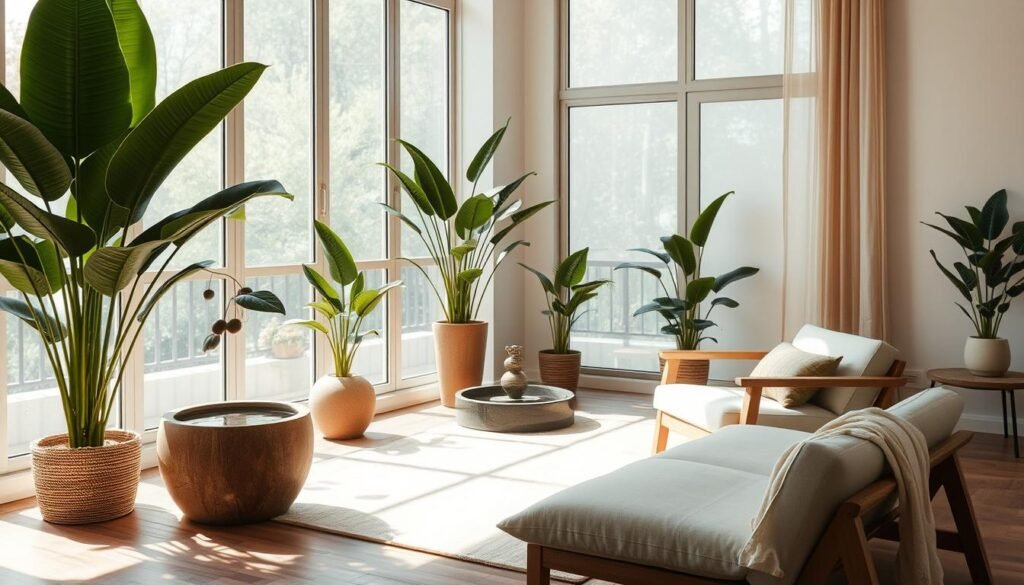
Minimalist Furniture Selection and Placement
To create a peaceful, Zen-inspired space, choose your furniture wisely. Look for pieces that are simple and calm. Pick low-profile, clean-lined sofas, chairs, and tables. This lets the natural elements and calm atmosphere shine.
How you arrange your furniture is key to a harmonious, zen furniture look. Place items to make the space flow smoothly and feel balanced. Make sure paths are clear and the layout is simple. Use negative space to add a peaceful home decor feel.
By picking and placing your furniture with care, you can turn any room into a calm retreat. Focus on simplicity and function. This way, you’ll make a minimalist interior design that encourages you to relax and enjoy your surroundings.
| Minimalist Furniture Essentials | Placement Techniques |
|---|---|
|
|
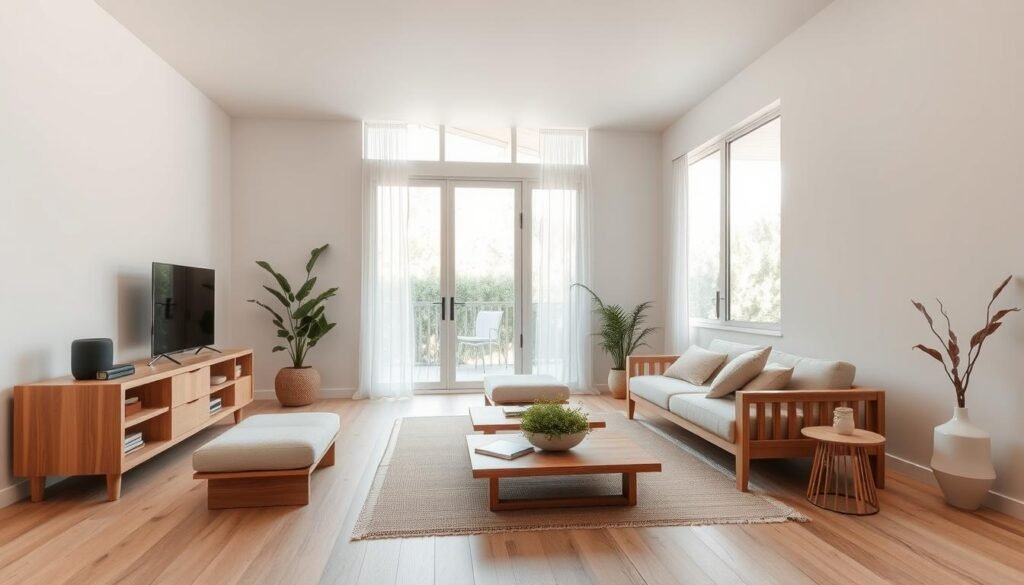
“The true essence of Zen lies in the art of simplicity and mindfulness. By carefully selecting and arranging your furniture, you can create a space that nourishes the soul and invites you to truly be present.”
Calming Color Palettes for Zen Spaces
Creating a serene, zen-inspired space begins with the right colors. Nature-inspired calming color palettes are essential for a peaceful vibe in your zen room decor and peaceful home decor. Choose from soothing neutrals, rejuvenating greens, and blues. These colors deeply affect your zen retreat’s atmosphere.
Nature-Inspired Color Schemes
Find inspiration in nature for your calming color palettes. Earthy tones like soft beiges, warm grays, and muted greens bring tranquility. These colors help blend indoor and outdoor spaces, fostering a natural connection.
Paint and Textile Combinations
- Pair muted blue-gray paint with natural linen for a calming, coastal feel.
- Complement khaki walls with organic cotton and bamboo for a cozy vibe.
- Choose soft greens for walls and throw pillows for a serene, nature-focused look.
Accent Color Integration
While a soothing base is key, calming color palettes can be enhanced with accent colors. Add muted terracotta, deep indigo, or earthy ochre through artwork, vases, or trays. These accents bring depth and interest to your zen room decor and peaceful home decor.
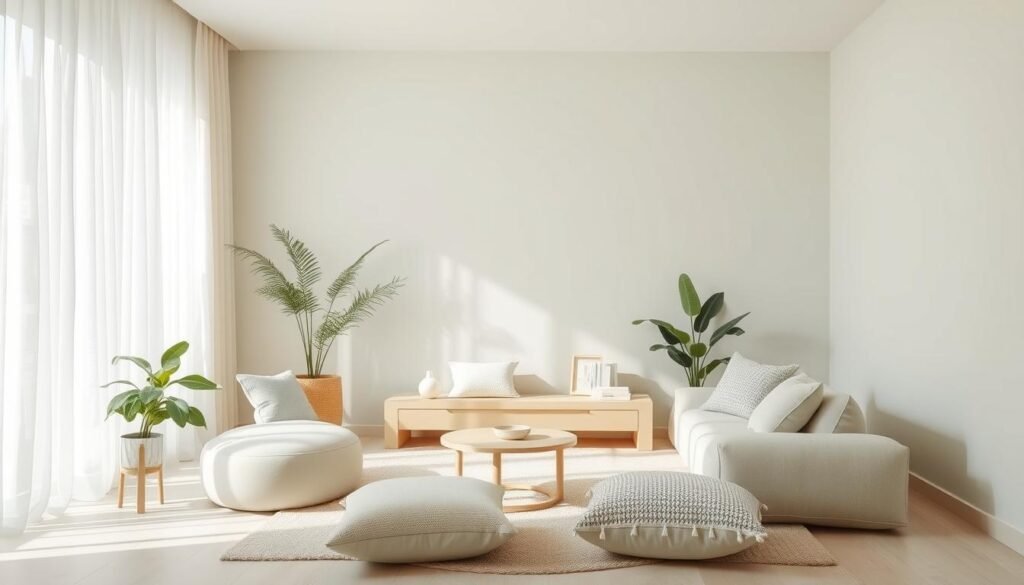
“Color is the keyboard, the eyes are the harmonies, the soul is the piano with many strings. The artist is the hand that plays, touching one key or another, to cause vibrations in the soul.” – Wassily Kandinsky
Lighting Solutions for Peaceful Ambiance
Creating a serene space for meditation or relaxation needs careful lighting. You can use natural light or soft artificial light to make a room peaceful. The right lighting can turn a room into a tranquil sanctuary.
Zen room decor focuses on natural elements. Start by letting natural light fill your space. Place furniture and decor near windows to enjoy daylight. Use zen room decor items like sheer curtains or paper lanterns to enhance the natural light.
When natural light isn’t enough, use gentle artificial light. Choose dimmable lamps with soft, warm tones for a calming effect. Place these lamps around the room for a gentle glow. Meditation room ideas often include candles or salt lamps for their soothing, flickering light.
With the right lighting, any space can become a peaceful home decor oasis. It promotes mindfulness and well-being. Let light help you create your own zen retreat.
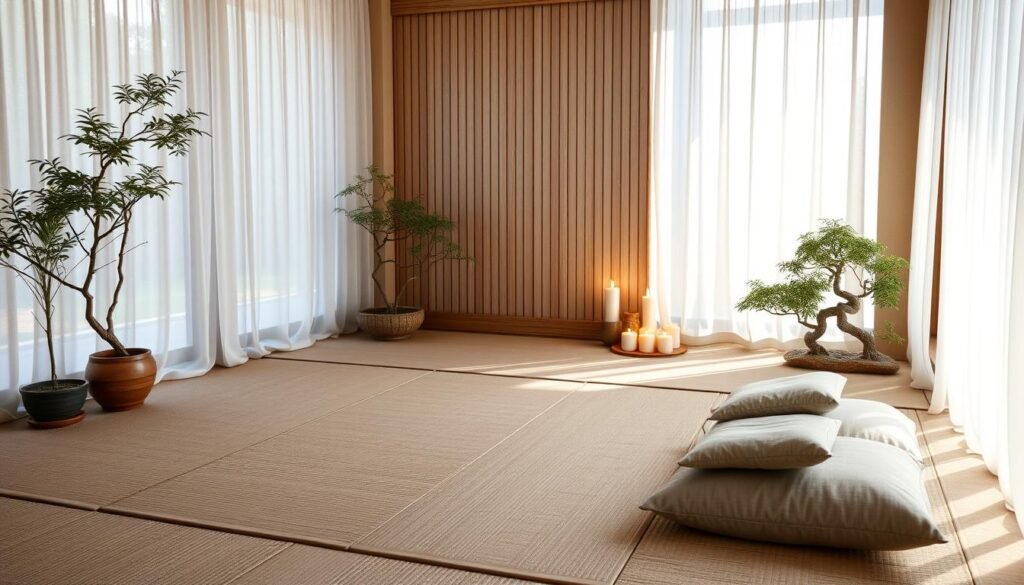
Japanese-Inspired Decorative Accents
Explore the world of Japanese-inspired interiors and let their calm beauty change your zen room decor. Discover the beauty of traditional Japanese art and add it to your peaceful home.
Traditional Art Elements
Calligraphy brings a touch of elegance with its flowing lines and deep meaning. Add delicate ikebana arrangements, the Japanese art of flower-arranging, for a natural feel. Hanging scrolls, traditional wall art, bring timeless serenity to your space.
Modern Japanese Design Integration
Mix traditional Japanese beauty with modern design. Use furniture with clean lines and minimalist accents for a zen feel. Add Japanese-inspired motifs through textiles, ceramics, or screens for a captivating look.
Symbolic Decor Pieces
- Introduce a Japanese Zen rock garden for tranquility and mindfulness.
- Display a Japanese Daruma doll for perseverance and goal-setting.
- Hang a Feng Shui wind chime for natural energy and positive vibes.
With these Japanese-inspired accents, your space will become a serene sanctuary. It invites you to find peace and balance.
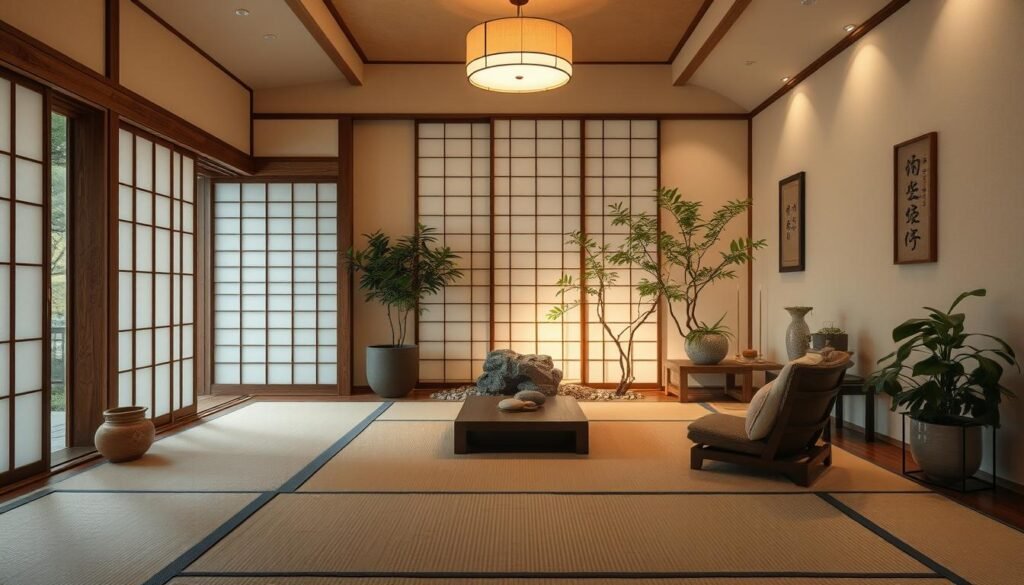
Conclusion
Exploring Zen room decor shows it’s more than just looks. It’s a way to make your space peaceful and mindful. By using natural materials, simple furniture, and soft colors, you can turn your home into a calm retreat.
This article has covered Zen design’s roots and its benefits. It’s a guide to making your home better. By following Zen’s principles and Feng Shui, you can improve your space’s energy flow. This brings balance and harmony to your home.
Whether you want a quiet meditation area or a peaceful living room, this article helps. It shows how to create a top 7 zen room decor, mindful living spaces, and peaceful home decor that fits your dream. Start your journey to a serene sanctuary with Zen-inspired design.
FAQ
What are the key elements of a Zen-inspired room design?
A Zen-inspired room uses natural materials like wood, bamboo, and stone. It also has minimalist furniture and calming colors. Elements like water features, bonsai trees, and simple art add to the Zen feel.
How can Feng Shui principles be applied to create a balanced Zen space?
To apply Feng Shui in a Zen room, start with the layout. Arrange furniture to improve energy flow and use colors that calm the mind. This creates a peaceful space.
What are the benefits of creating a Zen-inspired living space?
A Zen-inspired space helps you relax and reduces stress. It encourages mindfulness and focus. It’s perfect for meditation or a quiet break from daily life.
How can natural materials and textures be incorporated into Zen decor?
Using natural materials like bamboo, wood, and stone is key for Zen decor. Add natural textiles like linen and cotton. These elements make the space calming and grounding.
What are some effective lighting solutions for a Zen room?
Lighting is vital for a Zen room’s peaceful feel. Use natural light and soft artificial lighting. Candles or salt lamps add a warm glow.
How can Japanese-inspired decorative accents enhance a Zen room?
Japanese accents like calligraphy and ikebana add to a Zen room’s beauty. They bring harmony and mindfulness. Modern Japanese design also enhances the Zen feel.
What are some tips for selecting and arranging minimalist furniture in a Zen space?
Choose minimalist furniture that’s low-profile and simple. Arrange it to keep the space open and clutter-free. This creates a serene atmosphere.

Hello, I’m Jimmy, founder of Jimmy Cozy Life. I’m here to help you create a home that feels warm, stylish, and balanced. With ideas for decor, celebrations, wellness, and DIY projects, my goal is to share practical tips and a bit of inspiration to make your space truly special.
Disclosure: This post contains affiliate links. If you click and make a purchase, we may receive a small commission at no extra cost to you. The content on this website was developed with assistance from AI.



